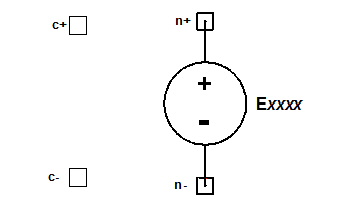|
微波射频仿真设计 |
|
|
微波射频仿真设计 |
|
| 首页 >> Ansoft Designer >> Ansoft Designer在线帮助文档 |
|
Nexxim Simulator > Voltage-Controlled Voltage Source, S-Domain
 S-Domain VCVS Netlist FormatThe S-domain voltage-controlled voltage source (SVCVS) uses the following netlist format: Exxxx n+ n- SVCVS c+ c- [GAIN=gain] [TC1=val] [TC2=val] NUMER=[a0 a1 ...] DENOM=[b0 b1 ...] n+ is the positive node and n- is the negative node of the source. The entry SVCVS is required to identify the SVCVS element type. c+ and c- are the positive and negative nodes for the control voltage. The element is specified using a transfer function given as the ratio of two polynomials in the complex variable s. The bold brackets for the NUMER and DENOM entries are required. The function of the device is expressed as: The transfer function H(s) is specified by giving the coefficients: 
The first coefficients in both numerator and denominator (a0 and b0) are constants, which must be specified even if they are zero. Thus, leading zeros are significant. In addition, intermediate zero-valued coefficients must be explicitly supplied in order to have the non-zero coefficients applied to the correct powers of s. Trailing zeros are not significant, and are automatically removed. The ratio of a0/b0 must be unity (when both a0¹0 and b0¹0). If the ratio is not unity, the numerator coefficients will be scaled to make it unity, before the GAIN is applied. For example, to specify the following transfer function (where coefficient a1=0): 
The netlist would be: E21 out gnd SVCVS out gnd NUMER=[1 0 2] DENOM=[1 1 3]
S-Domain VCVS Netlist ExampleE1 2 0 SVCVS 1 0 GAIN=2 NUMER=[0 0.5 1] DENOM=[1 2 3] This example implements the transfer function: 
HFSS视频教程 ADS视频教程 CST视频教程 Ansoft Designer 中文教程 |
|
Copyright © 2006 - 2013 微波EDA网, All Rights Reserved 业务联系:mweda@163.com |
|